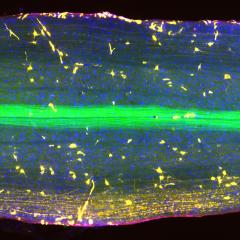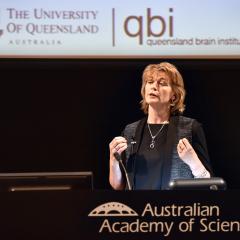
Bucket-loads of icy water dunked on Australian heads last year has translated into more than a million dollars, enough to pool a team of experts to find treatments for motor neurone disease (MND).
The $1.05 million MND Australia Ice Bucket Challenge Grant will allow clinicians and researchers from Australia’s leading motor neurone disease centres to work together, led by Professor Naomi Wray at The University of Queensland’s Queensland Brain Institute and Associate Professor Ian Blair at Macquarie University.
MND Research Institute of Australia (MNDRIA) Research Committee Chairman Professor Matthew Kiernan said it would be the largest collaborative project undertaken in Australia in the search for new motor neurone disease risk genes and therapies.
“Who would have thought that buckets of icy water would be such a powerful weapon?” Professor Kiernan said.
“We thank every one of the 30,000-plus soggy Australians who helped to catapult motor neurone disease into the global spotlight and donated to advance research,” he said.
Tens of thousands of Australians participated in the Ice Bucket Challenge by having a bucket of ice and water poured over their heads and uploading the footage to social media to raise awareness and drive fundraising.
“This collective goodwill has enabled the largest grant ever awarded by MNDRIA, which will underpin future research and allow people living with the disease to benefit from advances made through genomic medicine,” Professor Kiernan said.
There is no effective treatment and no known cure for motor neurone disease, which affects about 2000 Australians directly.
People with MND progressively lose the use of their limbs and the ability to speak, swallow and breathe, while their mind and senses usually remain intact.
The expert team will be called the Sporadic ALS Australian Systems Genomics Consortium (SALSA-SGC).
It will comprise 16 researchers from nine centres across Australia and international collaborators, who will work together to build an integrated infrastructure for the collection and analyses of biological samples and clinical data.
This pooled expertise will work together to better understand the causes of sporadic MND.
For the vast majority of those with MND, the diagnosis is sporadic, meaning they are an isolated case with no family history of the disease.
Professor Naomi Wray said the biology of motor neurone disease was complex and poorly understood, but there had been important research advances in the past five years.
“These advances have been driven almost entirely by gene discoveries from the small number of families where more than one person is affected,” she said.
Recent developments in technology have led to the discovery that people with sporadic MND may have genetic changes that could be risk factors for MND.
The SALSA-SGC team aims to collectively identify new risk genes through whole-genome analysis.
“Each new risk gene that we identify tells us a little more about motor neurone disease and is potentially a new therapeutic target,” Professor Wray said.
Key Facts about MND in Australia:
- MND is also known as ALS in some parts of the world and in the science community
- MND is a progressive, terminal neurological disease
- In most cases the cause is not known and there is no effective treatment and no known cure for MND
- People with MND progressively lose the use of their limbs and ability to speak, swallow and breathe, while their mind and senses usually remain intact
- Average life expectancy is two to three years after diagnosis
- Around 2000 people have MND in Australia.
For more information about MND visit www.mndaustralia.org.
Filming opportunities:
- Interview with Professor Matthew Keirnan (Sydney) and/or Professor Naomi Wray (Brisbane, available after Saturday 23 May)
- Interview with MND case studies in Sydney, Adelaide or Brisbane
- Lab footage in Sydney, Brisbane and Perth.
Media: QBI Communications, communications@qbi.uq.edu.au.





